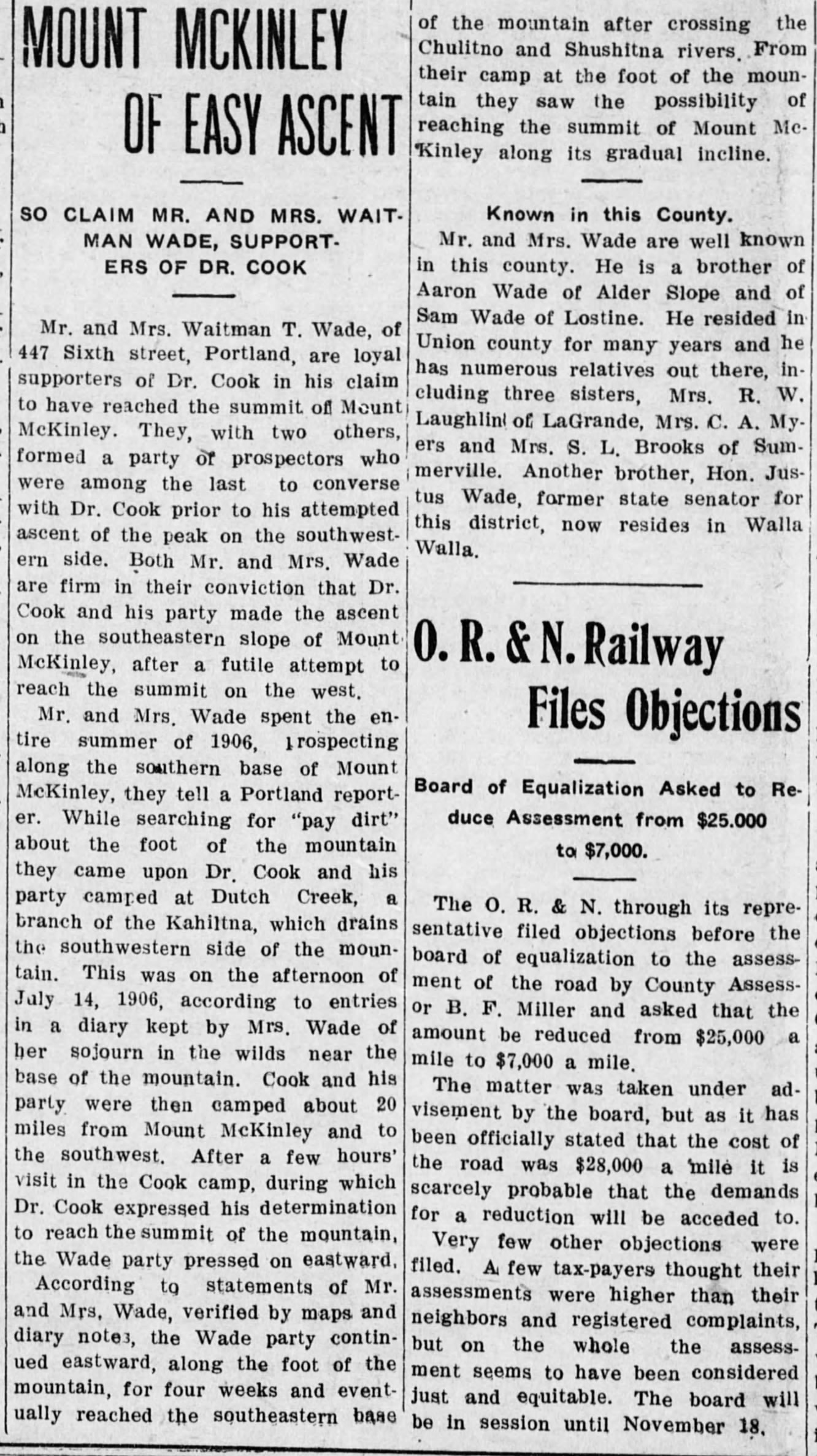Journals as a Communication Tool
This post will explore the purpose of Adams’ and Wade’s journals as communication technologies. Though both journals capture the events and timeline of trips out west, they differ in terms of their goals and the approaches used to record their authors’ experiences.
Why Did Nellie Martin Wade Write?
While Nellie Martin Wade may have wanted to capture the experience for her personal recollection, she intended for her writing to be published and read by a wide audience, as made clear throughout the journal. Her references to potential readers, as well as her desire to share her experiences in Alaska (at that time a region still unknown to many Americans), indicate this goal.
The prose in Wade’s writing, as well as the careful layout of the journal with a table of contents and chapter headings, indicate a detailed, thoughtful approach that might not be expected from an author traveling by horseback and facing the strenuous weather and travel conditions Wade details in the journal. The inclusion of editorial marks, inserted text in the margins, and crossouts are a sign of editing, which potentially took place after the trip. Nevertheless, it seems that she wrote at least some parts of this journal while in Alaska, as noted in an 1909 Oregonian newspaper article, which refers to “entries in a diary kept by Mrs. Wade of her sojourn in the wilds.”

This article also reveals another purpose of the journal: to provide evidence for another explorer’s accounts. Frederick Cook claimed to have summitted Mt. McKinley in 1906, and Wade writes about the success of his trip in the journal. However, two men who had joined Cook in 1906 questioned the photographs he had published, creating conflict. As seen in the article, the Wades disagreed, claiming in 1909 that Cook could in fact have succeeded, using the journal’s narrative as proof. It seems that this was not convincing, as Cook was shunned for his actions and is not accepted as the first settler to summit the mountain, but still demonstrates the value of the journal in contexts not anticipated by Wade.
Publication Possibilities
Though Wade never succeeded in publishing the journal, other small newspapers in the Pacific Northwest, including in Washington and Montana referenced the trip in connection to the Cook scandal. Researching the journal’s history prior to its purchase for the Western Americana Collections, the next mention of the journal appears in a 1972 newspaper article, featuring Naomi Martin, Nellie’s sister in law, who inherited the journal. The article notes that Martin tried to publish the journal, but was told “the style of writing was stilted and dated.” It’s not clear from this if Wade had personally attempted to publish the journal during her own life, or whether Martin’s attempt was the first.
One magazine chose to publish excerpts from the journal, and included Wade’s photographs (view them here). The selections emphasize the practical aspects of the trip, sounding more in line with the content in Adams’ journal. For example, there is a detailed description of the rations eaten on the trip, and descriptions of geography, prospecting sites, and other Alaskan towns. While some of Wade’s more poetic sections are included, it seems that her romantic tone is underrepresented in this article. Might this be connected to the judgement of her writing as “stilted and dated?”
While considering the question of whose work was and was not published, I considered Frederick Cook’s journal, which was published in 1908, not long after his trip. Like Wade, Cook writes in detailed prose, and includes images and a table of contents. Was Cook able to publish his journal more easily due to his status as a male explorer? Would his writing also have been rejected years later for being old-fashioned? I cannot conclusively answer these questions without knowing more about Wade’s attempts to publish, but the role of gender in publishing is a prominent undertone in this discussion.
Why Did Thomas Adams Write?
Thomas Adams’ journal, on the other hand, is much more documentary, and he focuses much more heavily on the tangible aspects of his trip. Gabriel Swift, curator of Western Americana at Firestone Library, told us that there are some questions as to whether or not Adams actually wrote the journal during his time with the Stevens Pacific Railroad Survey. For instance, there are not many examples of things being crossed out or ink being spilled or really any signs that would denote the work being created while on a long and perilous trip. However, even if there is a possibility that the journals were written later, I am inclined to believe that they were copied from another journal; the topics Adams talks about and the style in which he discusses them would line up with the fact that he at least took some form of notes on the journey.
References
“Barrill to Meet Cook at Lecture.” The Spokesman-Review. October 28, 1909.
Cook, Frederick Albert. To the Top of the Continent; Discovery, Exploration and Adventure in Sub-Arctic Alaska. The First Ascent of Mt. McKinley, 1903-1906. New York, 1908. http://hdl.handle.net/2027/njp.32101020795371.
Frederick A Cook - A Digital Exhibition. “Controversy - Frederick A Cook.” Accessed May 9, 2021. https://library.osu.edu/site/frederickcook/controversy/.
Martin, Naomi. “To Mt. McKinley On Horseback by Nellie Martin Wade.” Alaska: The Magazine of Life on the Last Frontier, June 1972.
McClure, Rosemary. “Bloomingtonite Tells of ’06 Alaska Trip.” San Bernardino Sun. June 28, 1972.
“Mount McKinley of Easy Ascent.” Enterprise News-Record. November 3, 1909.
